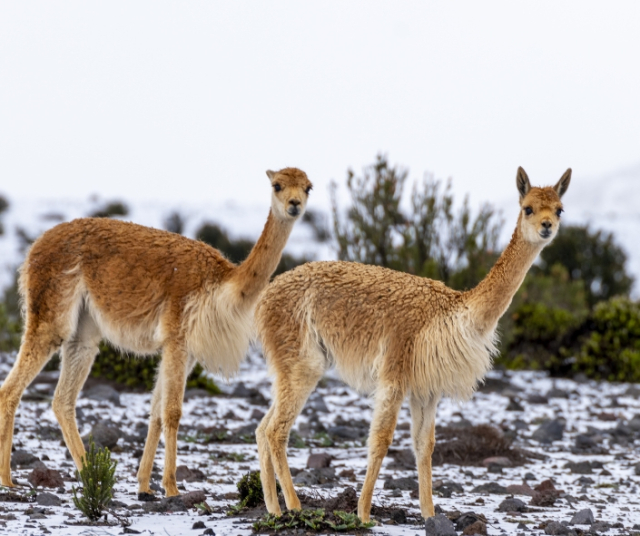Vicuñas, majestic South American camelids, are living treasures of the Peruvian Andes. These elegant animals, relatives of llamas and alpacas, have been an integral part of Peruvian culture for millennia.
History and culture
Vicuñas, with their elegance and grace, have woven their presence into the historical and cultural tapestry of Peru for millennia. From pre-Inca civilizations to contemporary times, these majestic creatures have played an essential role in the country's identity, contributing significantly to Peruvian cultural wealth and heritage.
At the dawn of Peruvian history, civilizations such as the Chavín culture recognized the extraordinary value of vicuña wool, considering it the "gold of the Andes." The fine, soft fiber of the vicuñas not only offered protection against the inclement weather in the Andean highlands, but also stood as a symbol of status and prestige. From early on, the Peruvian people learned to appreciate the subtlety and quality of vicuña wool, elevating it to an exclusive status destined for nobility and royalty.
The arrival of the Incas further cemented the connection between vicuñas and Peruvian culture. The Incas implemented strict regulations for hunting vicuñas, recognizing the importance of preserving both the species and its valuable resource. Vicuña wool became a central element in the daily and ceremonial life of the Inca empire. Their trade, carefully regulated, was integrated into the commercial networks that crossed the vast Andean lands.
Respect for vicuñas transcended the material; These creatures were also considered sacred. Its presence in Inca mythology was intertwined with divinities, symbolizing the intrinsic connection between nature and spirituality. In many ways, vicuñas became guardians of Peruvian cultural identity, guarding the natural wealth of the highlands.
As time passed, however, the vicuñas faced significant challenges. Overhunting and habitat loss threatened the very existence of these once-revered creatures. In response, the Peruvian government took bold steps to preserve this centuries-old legacy. Conservation measures were implemented, protected areas were established, and vicuña hunting was prohibited. These efforts not only sought to preserve a species, but also to protect an invaluable component of Peru's cultural heritage.
The inextricable link between vicuñas and Peruvian culture resurfaced with the successful recovery of the populations of these creatures. The rebirth of the vicuña wool industry marked not only an economic revitalization, but also the preservation of a tradition that dates back centuries. Local communities, with their knowledge passed down from generation to generation, played a crucial role in the sustainable management of this industry, respecting the balance between tradition and conservation.
Conservation of Vicuñas
The story of vicuña conservation in Peru is an inspiring story of resilience and collaboration between nature and society. These elegant creatures, which once faced the threat of overhunting and habitat loss, have experienced a remarkable recovery thanks to the concerted efforts of conservationists, local communities and the Peruvian government.
In the 20th century, vicuña populations in Peru faced an alarming decline, placing them on the list of endangered animals. Illegal hunting and competition for natural resources presented significant challenges to the survival of these majestic Andean creatures. Faced with this imminent crisis, the Peruvian government took bold measures to reverse the situation and preserve an invaluable natural heritage.
The creation of protected areas was a fundamental pillar of the conservation strategy. These carefully designated sanctuaries in the highlands of the Andes provided refuge for the vicuñas, allowing them to breed and thrive in a safe environment. The implementation of strict anti-poaching laws and severe penalties for those who violated these regulations demonstrated the Peruvian government's determined commitment to protecting these endangered species.
However, vicuña conservation was not limited only to the creation of protected areas and the imposition of legal restrictions. Education and awareness played a fundamental role in transforming the relationship between local communities and the vicuñas. Educational programs aimed at populations that shared their environment with these creatures taught the importance of coexistence and the need to preserve ecological balance.
The Rise of the Vicuña Wool Industry
With the recovery of vicuña populations, the vicuña wool industry experienced a resurgence in Peru. Vicuña fiber is considered one of the finest and softest in the world, making it a highly coveted luxury material. Demand for vicuña wool products, such as shawls, sweaters and scarves, has led to a boom in the Peruvian textile industry.
Local pastoralists and Andean communities have benefited economically from this growing industry. Sustainable vicuña farming has become a vital source of income for many rural communities, promoting the conservation of these species and the preservation of their natural habitats.
Sustainable Tourism and Vicuñas Observation
The successful conservation of vicuñas has also contributed to the development of sustainable tourism in Peru. Many protected areas have implemented vicuña viewing programs, giving visitors the unique opportunity to witness these majestic animals in their natural environment. These initiatives not only generate income for local communities, but also raise awareness about the importance of wildlife conservation and preservation.
Despite successes in vicuña conservation in Peru, significant challenges still exist. Climate change, habitat loss, and continued pressure on natural resources pose ongoing threats to these species. It is imperative that Peru and the international community continue to collaborate on the implementation of effective strategies to ensure the long-term survival of vicuñas.
Furthermore, sustainable management of the vicuña wool industry is essential. The balance between market demand and the conservation of natural populations must be carefully maintained to avoid overexploitation and the risk of reversing conservation gains.
